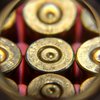edwardware
Member
- Joined
- Feb 23, 2010
- Messages
- 4,424
Does anyone know the doctrinally correct method to remove the firing pin bushing from a Smith 642-2? Recall this is a hammerless, aluminum, j-frame.
I've been given an almost new 642-2 that's been the victim of a 'gunschmit' (hence the cut down hammer spring, inconsistent ignition, and carmelized grease) and cheap handloads. At some point the cheap handloads ruptured a primer and gas cut the bushing.
I would like to replace the bushing. Can I reassemble the gun without the firing pin retaining pin and let the firing pin drive it out?

ETA: Well, the firing pin will not drive the bushing out. . . I suspect an EZ-Out type tool down the barrel.
I've been given an almost new 642-2 that's been the victim of a 'gunschmit' (hence the cut down hammer spring, inconsistent ignition, and carmelized grease) and cheap handloads. At some point the cheap handloads ruptured a primer and gas cut the bushing.
I would like to replace the bushing. Can I reassemble the gun without the firing pin retaining pin and let the firing pin drive it out?

ETA: Well, the firing pin will not drive the bushing out. . . I suspect an EZ-Out type tool down the barrel.
Last edited:





